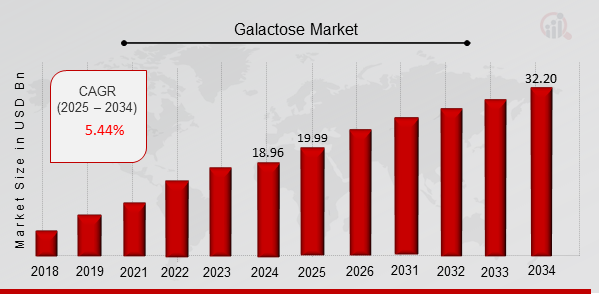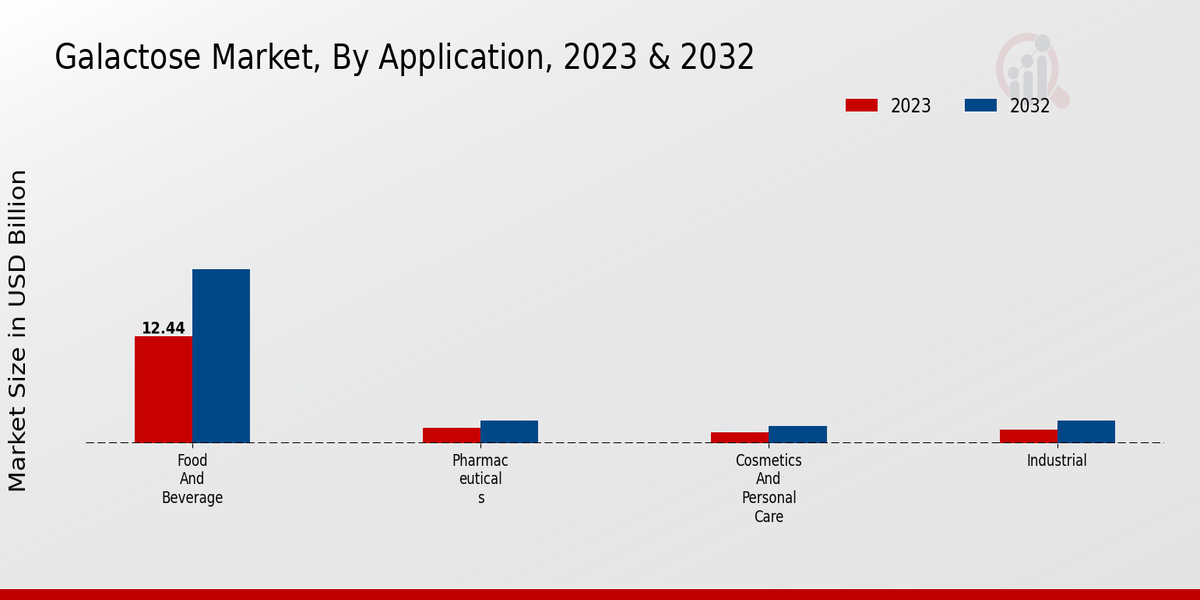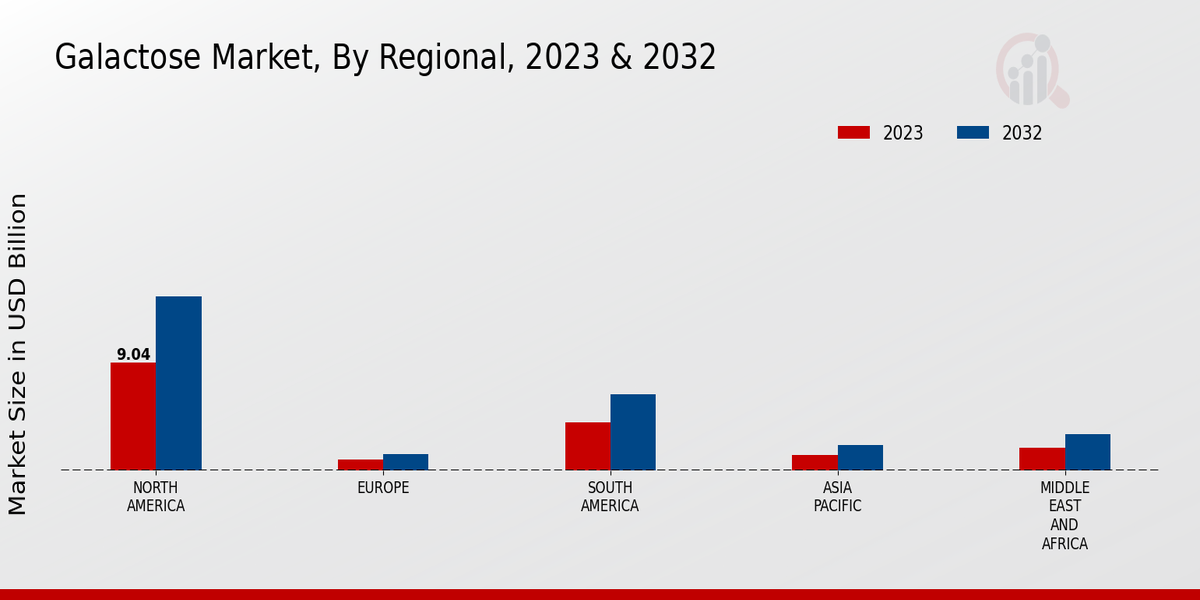Global Galactose Market Overview
As per MRFR analysis, the Galactose Market Size was estimated at 18.96 (USD Billion) in 2024. The Galactose Market Industry is expected to grow from 19.99 (USD Billion) in 2025 to 32.20 (USD Billion) till 2034, at a CAGR (growth rate) is expected to be around 5.44% during the forecast period (2025 - 2034).
Key Galactose Market Trends Highlighted
Ongoing advancements in healthcare and research have underscored the importance of galactose in biomedical applications and drug development. Increasing utilization of galactose as a key ingredient in infant formula, pharmaceuticals, and dietary supplements has been a significant growth driver.
Moreover, expanding research efforts in galactosemia management, lactose intolerance mitigation, and its role in metabolism have fueled market growth.
The rising prevalence of lactose intolerance and the need for alternative sweeteners provide opportunities for market expansion. The development of novel galactose-based products with enhanced functionalities, such as reduced-sugar formulations and prebiotics, cater to evolving consumer preferences and dietary restrictions.
Advancements in biotechnology and enzyme engineering are also enabling cost-effective production and unlocking new avenues for market growth.
Recent trends include the integration of galactose in functional foods and nutraceuticals due to its prebiotic properties and potential health benefits.
Additionally, increasing awareness about the role of galactose in energy metabolism and its potential in sports nutrition has opened new avenues for exploration.
The growing adoption of galactose in research and clinical settings for studying metabolic disorders and developing therapeutic interventions is further contributing to market growth.

Source: Primary Research, Secondary Research, MRFR Database and Analyst Review
Galactose Market Drivers
Rising Demand for Galactose in the Food and Beverage Industry
The main consumer of galactose is the food and beverage industry as this substance is a widely used sweetener and thickening agent. The rising consumption of processed food and beverages is predicted to boost the development of the galactose market.
In addition, galactose is also used for the production of infant formula and other dairy products, making a significant contribution to the growth of the market.
Moreover, the increasing popularity of plant-based milk substitutes, such as soy milk or almond milk, is another factor boosting the demand for galactose as it is used for such drinks as a natural sweetener.
Growth of the Pharmaceutical Industry
Galactose is an important raw material used in the production of a variety of pharmaceutical products, including antibiotics, vitamins, and hormones.
The growth of the pharmaceutical industry is expected to drive the demand for galactose. Galactose is also used in the production of medical imaging agents and other diagnostic tools, which is further contributing to the growth of the Galactose Market.
Technological Advancements in Galactose Production
Technological advancements in the production of galactose are expected to drive the growth of the galactose market. These advancements include the development of more efficient and cost-effective production methods, as well as the use of renewable feedstocks.
The use of enzymes in the production of galactose is also becoming more common, which is further contributing to the growth of the Galactose Market.
Galactose Market Segment Insights:
Galactose Market Application Insights
Application Segment Overview The Galactose Market has been segmented, based on application, into Food and Beverage, Pharmaceuticals, Cosmetics and Personal Care, and Industrial. The Food and Beverage segment is expected to dominate the Galactose Market throughout the forecast period.
Galactose is used as a sweetener in food and beverages, and the demand for low-calorie and sugar-free products is driving the growth of this segment. The Food and Beverage segment held the largest share of the market in 2023.
The Pharmaceuticals segment is expected to register a significant growth rate as the prevalence of lactose intolerance increases, and galactose is used in the production of pharmaceuticals, such as antibiotics and anti-inflammatory drugs.
The Cosmetics and Personal Care segment is expected to grow at a steady rate due to the rising use of galactose in skincare and haircare products.
It is used for its moisturizing and anti-aging properties and is increasingly used in many cosmetic products. The market is set to grow due to the increasing demand for galactose across food and beverage, pharma, and other industrial applications.

Source: Primary Research, Secondary Research, MRFR Database and Analyst Review
Galactose Market Source Insights
The Galactose Market is segmented by Source as Lactose, Whey, Starch, and Cellulose. Lactose serves as the source for galactose, holding the leading position with respect to the market share.
Whey is the second largest source, having a growing demand for the whey protein isolate and other products that are emerging from whey. Starch also serves as a source of galactose.
Cellulose, a fiber found in plants, also serves as a source of galactose. These are under research and are in the early stages of commercialization. The Galactose Market revenue from the lactose-obtained galactose is expected to reach USD 10.24 Billion by 2024.
The revenue from whey is expected to reach USD 4.56 Billion by 2024. The revenue from the starch source is expected to be around USD 2.1 billion in 2024. Cellulose is in the early stages of development.
Galactose Market Grade Insights
The Galactose Market segmentation by Grade comprises Food Grade, Pharmaceutical Grade, and Industrial Grade. The Pharmaceutical Grade segment held the largest market share in 2023 and is projected to continue its dominance throughout the forecast period.
The growth of this segment is attributed to the increasing demand for galactose in the pharmaceutical industry, particularly for the production of lactose-free infant formula and other medical products.
The food-grade segment is anticipated to witness steady growth over the coming years due to the rising demand for galactose in the food and beverage industry, especially in the production of dairy products and confectioneries.
The Industrial Grade segment is expected to experience moderate growth, driven by the increasing use of galactose in various industrial applications, including the manufacturing of adhesives, paper, and textiles.
Overall, the Grade segmentation of the Galactose Market is expected to exhibit significant growth in the coming years, with the Pharmaceutical Grade segment remaining the dominant contributor to the market revenue.
Galactose Market Product Type Insights
Crystalline Galactose, Powdered Galactose, and Liquid Galactose are the three main product types in the Galactose Market. Crystalline Galactose holds the largest market share due to its wide range of applications in the food and beverage industry as a sweetener and in pharmaceutical applications as an excipient.
Powdered Galactose is gaining popularity in the food industry as a sugar substitute and in the pharmaceutical industry as a carrier for active pharmaceutical ingredients.
Liquid Galactose is primarily used in the food industry as a sweetener and in the pharmaceutical industry as a culture medium for cell growth.
The Galactose Market is expected to witness significant growth in the coming years, driven by increasing demand from the food and beverage industry and the pharmaceutical industry.
Galactose Market Regional Insights
The Galactose Market segmentation by region offers insights into the market's regional performance and competitive landscape.
North America is expected to account for a significant share of the Galactose Market revenue due to the presence of key industry players and well-established healthcare infrastructure.
The region is projected to continue its dominance throughout the forecast period, driven by increasing R investments and rising demand for galactose in various applications.
Europe holds the second-largest share in the Galactose Market, with key countries such as Germany, France, and the United Kingdom contributing significantly to the regional market growth.
The increasing adoption of galactose in the food and beverage industry, coupled with growing awareness about its health benefits, is expected to drive the market in Europe. The APAC region is anticipated to exhibit the highest growth rate during the forecast period.
This growth can be attributed to the rising demand for galactose in pharmaceuticals and nutraceuticals, particularly in countries like India, China, and Japan.
South America and the MEA region are also expected to witness steady growth in the Galactose Market, driven by increasing healthcare expenditure and rising awareness about galactose's potential benefits.

Source: Primary Research, Secondary Research, MRFR Database and Analyst Review
Galactose Market Key Players and Competitive Insights:
Major players in the Galactose Market are continuously seeking to achieve a competitive edge through investments in research development, changes in product portfolios, and establishing contracts with suppliers.
On account of the growing demand for galactose products companies operating in the market are currently focusing on expanding their production capacity. Major manufacturers of galactose products on the market are also continuing their efforts aimed at development of new, innovative products, with prebiotic properties such as galacto-oligosaccharides.
Created in research departments of major galactose product manufacturers, new products are launched in order to meet the growing demand from customers for galactose products. At the same time, it should be noted that the development of the Galactose Market is greatly influenced by government regulations and policies, which are designed in order to ensure the safety, healthiness, and quality of the products.
The structure of the Galactose Market is expected to continue to be variable, due to the emergence of new players in the market and mergers and acquisitions taking place on the market. Cargill, Incorporated is a key player in the Galactose Market.
The company has a strong global reach and an extensive product portfolio. Cargill, Incorporated has a long history of delivering high-quality galactose products and has a strong focus on innovation. Cargill Incorporated one of key manufacturers of new galactose-based products in the form of galacto-oligosaccharides.
In recognition of the recent development of the Galactose Market, Cargill, Incorporated has focused on expanding its production capacity. Another major player in the industry is Friesland Campina DMV, a global manufacturer of dairy products.
Main products of the company include lactose, GOS, and galactose. Friesland Campina DMV has an extensive, global distribution network and a strong commitment to the principles of sustainability.
Products of the company are produced using renewable energy sources and the company has a global strategy of sustainable operations.
Key Companies in the Galactose Market Include:
- FrieslandCampina
- Kerry Group plc
- J Scientific Ltd.
- Tate Lyle PLC
- Sigma-Aldrich
- Hansen Holding A/S
- Cargill, Incorporated
- Koninklijke DSM N.V.
- BASF SE
- Ingredion Incorporated
- Tokyo Chemical Industry Co., Ltd.
- Archer Daniels Midland Company
- Fonterra Cooperative Group Limited
Galactose Market Developments
The market growth is primarily driven by the increasing demand for galactose in the food and beverage industry, particularly in the production of lactose-free dairy products.
Additionally, the growing adoption of galactose in pharmaceutical applications, such as the treatment of galactosemia and the development of novel drug therapies, is contributing to the market expansion.
Recent news developments in the market include the approval of new galactose-based drugs by regulatory authorities and the strategic partnerships between
Key players to enhance production capacity and distribution networks. The market is expected to witness continued growth in the coming years due to the rising prevalence of lactose intolerance and the increasing demand for functional food ingredients.
Galactose Market Segmentation Insights
- Galactose Market Application Outlook
- Food and Beverage
- Pharmaceuticals
- Cosmetics and Personal Care
- Industrial
- Galactose Market Source Outlook
- Lactose
- Whey
- Starch
- Cellulose
- Galactose Market Grade Outlook
- Food Grade
- Pharmaceutical Grade
- Industrial Grade
- Galactose Market Product Type Outlook
- Crystalline Galactose
- Powdered Galactose
- Liquid Galactose
- Galactose Market Regional Outlook
- North America
- Europe
- South America
- Asia Pacific
- Middle East and Africa
| Report Attribute/Metric |
Details |
|
Market Size 2024
|
18.96 (USD Billion)
|
|
Market Size 2025
|
19.99 (USD Billion)
|
|
Market Size 2034
|
32.20 (USD Billion)
|
|
Compound Annual Growth Rate (CAGR)
|
5.44 % (2025 - 2034)
|
|
Report Coverage
|
Revenue Forecast, Competitive Landscape, Growth Factors, and Trends
|
|
Base Year
|
2024
|
|
Market Forecast Period
|
2025 - 2034
|
|
Historical Data
|
2020 - 2024
|
| Market Forecast Units |
USD Billion |
| Key Companies Profiled |
FrieslandCampina, Kerry Group plc, J Scientific Ltd., Tate Lyle PLC, SigmaAldrich, Chr. Hansen Holding A/S, Cargill, Incorporated, Koninklijke DSM N.V., BASF SE, Ingredion Incorporated, Tokyo Chemical Industry Co., Ltd., Archer Daniels Midland Company, Fonterra Cooperative Group Limited |
| Segments Covered |
Application, Source, Grade, Product Type, Regional |
| Key Market Opportunities |
Growing demand for lactose-free dairy products Rising applications in infant formulas Increasing use of pharmaceuticals Emerging opportunities in functional foods Expanding application in biotechnology |
| Key Market Dynamics |
Rising health concerns Growing demand for the food and beverage industry Increasing adoption of galactose in dietary supplements Technological advancements Expanding applications in pharmaceuticals |
| Countries Covered |
North America, Europe, APAC, South America, MEA |
Frequently Asked Questions (FAQ) :
The Galactose Market reached 17.05 billion USD in 2023.
The Galactose Market is projected to reach 27.457 billion USD in 2032.
The Galactose Market is expected to grow at a CAGR of 5.44% from 2025 to 2034.
North America held the largest market share in the Galactose Market in 2023.
Asia Pacific is expected to experience the highest growth rate in the Galactose Market from 2025 to 2034.
Galactose is primarily used in the food and beverage industry, as well as in pharmaceuticals and personal care products.
Some of the key competitors in the Galactose Market include Cargill, Ingredion, and Tate Lyle.
The growing demand for Galactose in the food and beverage industry, as well as the increasing use of Galactose in pharmaceuticals and personal care products, are key factors driving the growth of the Galactose Market.
The high cost of production and the limited availability of raw materials are key challenges facing the Galactose Market.
The growing popularity of Galactose-based food and beverages, as well as the increasing use of Galactose in pharmaceuticals and personal care products, are key trends in the Galactose Market.

















